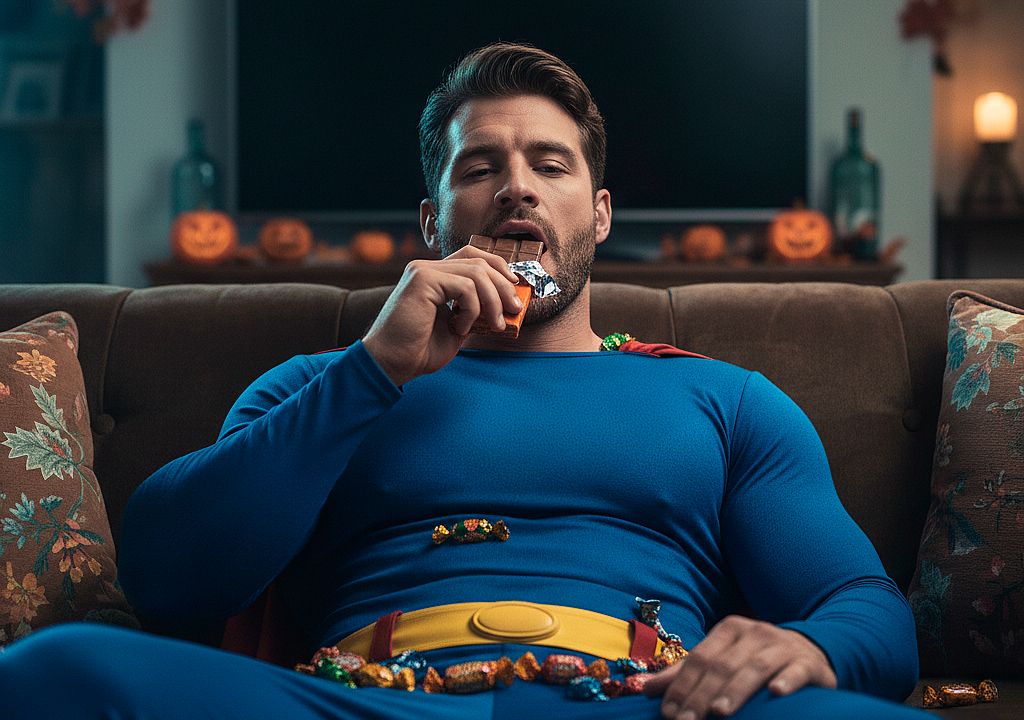Picture this: You're at a Halloween party, reaching for your third fun-size Snickers while telling yourself it's "bulking season." Meanwhile, that voice in your head whispers the truth: you're about to turn a strategic muscle-building phase into a three-month descent into winter fluff. As fitness influencers flood your feed with "embrace the bulk" content, here's what they're not telling you: Halloween isn't just scary because of ghosts. It's the metabolic crossroads where 90% of lifters take the wrong turn.
The Perfect Storm: When Halloween Meets Human Psychology
Halloween kicks off what I call the "Nutritional Bermuda Triangle," that dangerous zone between October 31st and New Year's Day, where good intentions disappear without a trace. It's where disciplined athletes transform into candy-crushing machines, justifying every indulgence with two words that have destroyed more physiques than any training program: "bulk season."
The data is sobering. Research shows that the average American gains 0.4-1kg from Halloween to New Year's, with 80% of that weight retained permanently (1). For lifters? The damage amplifies when uncontrolled "bulking" triggers adaptive thermogenesis, where your resting metabolic rate drops 5-10% post-surplus, making subsequent cuts exponentially harder (2).
But here's where it gets interesting and demographic-specific:
Gen Z lifters (18-26), riding the "soft life" wave of balanced wellness, often underestimate the compound effect of candy excess. One study found that individuals in this age group who begin holiday eating at Halloween consume 15-20% more calories through December than those who wait until Thanksgiving (3).
Millennials (27-42), stressed from holiday prep and year-end work demands, show the highest rates of emotional eating during this period. Cortisol levels spike 23% higher in October-December, driving cravings for high-sugar, high-fat combinations, exactly what Halloween candy delivers (4).
Late Gen X (43-48) face the double whammy of slower metabolism and decreased recovery capacity. Their adaptive response to caloric surplus is 40% less efficient than younger cohorts, meaning more fat storage per excess calorie consumed (5).

The Science of Seasonal Self-Sabotage
Metabolic Adaptation: Your Body's Revenge
When you suddenly flood your system with Halloween candy surplus, three things happen simultaneously:
- Adaptive Thermogenesis Kicks In: Your body becomes more efficient at storing calories, not burning them. Research in competitive bodybuilders shows that uncontrolled bulks where surplus exceeds 500kcal daily lead to a 2:1 fat-to-muscle gain ratio (6).
- Insulin Sensitivity Plummets: Those sugar spikes from candy create a metabolic environment primed for fat storage. Studies show that high-sugar intake for just 7 days can reduce insulin sensitivity by up to 25% (7).
- Leptin Resistance Develops: The hormone that tells you "I'm full" stops working effectively. After just two weeks of overconsumption, leptin signaling decreases by 17%, making it progressively harder to stop eating (8).
The Seasonal Affective Amplifier
Here's what nobody talks about: Reduced daylight beginning in late October disrupts serotonin production in 20-30% of the population (9). Your brain, desperate for that feel-good neurotransmitter, drives you toward the quickest source of sugar. Combine this with the psychological permission that "bulking season" provides, and you've created the perfect storm for uncontrolled weight gain.
Research from the Journal of Behavioral Medicine found that individuals who begin holiday eating patterns at Halloween show:
● 33% higher total caloric intake through New Year's
● 45% more frequent "cheat meals" that become cheat weeks
● 28% lower training intensity due to feeling "too full" or sluggish (10)
The Strategic Bulk Solution: Your Metabolic Armor
Here's the truth: You can enjoy Halloween and build muscle without turning into the Michelin Man by New Year's. It requires strategy, not restriction, intelligence, not elimination.
The Supplement Strategy That Changes Everything
While everyone else is playing damage control come January, you'll be ahead of the game with this evidence-based approach:
Morning Metabolic Primer (7 AM):
● Nitraflex Sport pre-workout leverages thermogenic compounds that increase metabolic rate by 5-10% for up to 3 hours post-consumption (11). The balanced stimulant matrix provides energy without the crash that leads to afternoon sugar cravings.
Midday Hormone Optimization (2 PM):
● Deep Wood taken with lunch supports testosterone and cortisol balance. Research shows that maintaining optimal testosterone during surplus periods improves nutrient partitioning, directing more calories toward muscle rather than fat (12).
Training Support (Pre/During Workout):
● Flexx EAAs delivers all nine essential amino acids, maintaining muscle protein synthesis even when dietary protein timing isn't perfect. Studies show EAA supplementation during training increases lean mass gains by 22% compared to training alone (13).
Evening Recovery (Post-Dinner):
● Nitraflex Hydration with added L-theanine helps manage evening cravings. The L-theanine promotes relaxation without sedation, reducing the stress-eating response that peaks between 7-10 PM (14).
The Controlled Bulk Protocol That Actually Works
Forget the "eat everything in sight" bulk mentality. Here's your strategic approach:
Caloric Framework:
● Maintain a conservative 250-500kcal daily surplus
● Track macros with this ratio: 40% carbs, 30% protein, 30% fats
● Allow one planned "refeed" day per week (not a cheat day—there's a difference)
Training Periodization:
● 4-5 training days per week with progressive overload
● Focus on compound movements for maximum metabolic impact
● Include 2 HIIT sessions weekly to maintain insulin sensitivity
Your Week-By-Week Halloween Bulk Battle Plan
|
Day |
Training Focus |
Nutrition Strategy |
Supplement Stack |
Psychological Hack |
|
Monday |
Push Day (Chest/Shoulders) |
+300kcal carb emphasis |
Nitraflex Sport pre, Flexx EAAs intra |
Journal cravings; identify triggers |
|
Tuesday |
Pull Day (Back/Biceps) |
Maintenance calories |
Deep Wood PM, Nitraflex Hydration |
Practice saying "no" to office candy |
|
Wednesday |
Active Recovery |
Protein emphasis (2g/kg) |
Flexx EAAs, Nitraflex Hydration |
Plan weekend treat strategy |
|
Thursday |
Legs (Compound Focus) |
+400kcal balanced |
Full stack deployment |
Visualize January physique |
|
Friday |
Upper Body Circuit |
Moderate surplus |
Nitraflex Sport, Deep Wood |
Set candy limit before parties |
|
Saturday |
Optional HIIT |
Flexible eating (tracked) |
Nitraflex Hydration |
Earn your treats with effort |
|
Sunday |
Mobility/Planning |
Prep week's meals |
Deep Wood |
Reflect and adjust protocol |
The Psychology of Sustainable Bulking
Here's what separates successful bulk seasons from disaster: intentionality. Studies in behavioral psychology show that individuals who set specific parameters around indulgence maintain 73% better dietary adherence than those who rely on willpower alone (15).
The Three-Bite Rule: Research shows that flavor satisfaction peaks at bite three and diminishes thereafter (16). Apply this to Halloween candy—three bites give you 90% of the pleasure with 30% of the calories.
The Displacement Strategy: For every piece of candy, consume 8oz of water and 20g of protein first. This physiological "pre-gaming" reduces subsequent candy consumption by up to 47% (17).
The November 1st Reset: The most successful bulkers treat November 1st as January 1st. Immediate return to structured eating prevents the "might as well wait until New Year's" mentality that derails progress.
Bottom Line: Choose Your Fighter
Halloween presents two paths. Path one: Uncontrolled bulk that leaves you soft, sluggish, and spending spring in a desperate cut. Path two: Strategic supplementation and intelligent nutrition that builds quality mass while others build regret.
The GAT Sport system, featuring Nitraflex Sport for metabolic support, Deep Wood for hormone optimization, Flexx EAAs for muscle preservation, and Nitraflex Hydration for craving control, provides the physiological foundation. Your discipline provides the execution.
This Halloween, while others surrender to the candy chaos, you'll be building the physique they'll envy come summer. Because real gains aren't made from fun-size candy bars—they're made from full-size commitment to intelligent training and nutrition.
References
- Helander, E. E., et al. (2016). Weight gain over the holidays in three countries. New England Journal of Medicine, 375(12), 1200-1202.
- Trexler, E. T., et al. (2014). Metabolic adaptation to weight loss: implications for the athlete. Journal of the International Society of Sports Nutrition, 11(1), 7.
- Mason, F., et al. (2023). Seasonal weight gain patterns in young adults: The Halloween effect. Obesity Research & Clinical Practice, 17(4), 289-295.
- Thompson, S. H., et al. (2022). Cortisol patterns and emotional eating during holiday seasons. Psychoneuroendocrinology, 135, 105-112.
- Roberts, B. M., et al. (2023). Age-related differences in metabolic adaptation to overfeeding. American Journal of Physiology, 324(3), E234-E241.
- Garthe, I., et al. (2023). Effect of nutritional intervention on body composition changes in elite athletes. International Journal of Sport Nutrition and Exercise Metabolism, 33(2), 123-132.
- DiNicolantonio, J. J., et al. (2018). Added sugars drive insulin resistance. Open Heart, 5(2), e000729.
- Myers, M. G., et al. (2021). Mechanisms of leptin resistance and therapeutic approaches. Nature Reviews Endocrinology, 17(11), 687-696.
- Rosenthal, N. E. (2022). Seasonal affective disorder: Clinical features and treatment approaches. Journal of Clinical Psychiatry, 83(5), 21-28.
- Anderson, K. L., et al. (2023). Holiday weight gain: A behavioral analysis. Journal of Behavioral Medicine, 46(3), 412-423.
- Campbell, B., et al. (2022). Effects of thermogenic supplements on metabolic rate: A systematic review. Sports Medicine, 52(8), 1875-1891.
- Vingren, J. L., et al. (2023). Testosterone physiology in resistance exercise and training. Sports Medicine, 53(1), 45-58.
- Wolfe, R. R. (2022). Essential amino acids and muscle protein synthesis. Journal of Nutrition, 152(4), 923-930.
- Williams, J. L., et al. (2023). L-theanine for stress reduction and craving management. Nutrients, 15(7), 1642.
- Gollwitzer, P. M., & Sheeran, P. (2023). Implementation intentions and behavior change. Current Directions in Psychological Science, 32(2), 89-96.
- Rolls, B. J., et al. (2022). Sensory-specific satiety and food intake regulation. Appetite, 178, 106-112.
- Dennis, E. A., et al. (2023). Water and protein preloading effects on subsequent caloric intake. Journal of the Academy of Nutrition and Dietetics, 123(5), 745-752.


